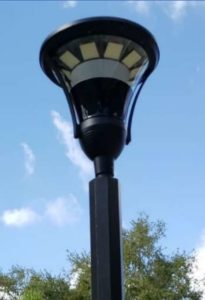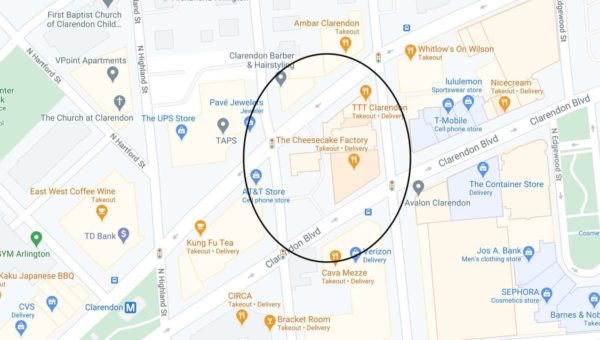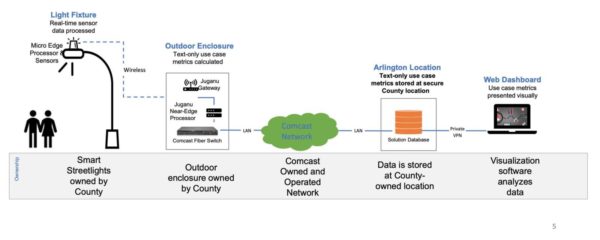As early as mid-spring, light poles along Wilson Blvd in Clarendon will be outfitted with new fixtures that monitor crowds and identify potential emergencies.
The technology will be installed sometime this spring as part of a pilot project involving multiple Arlington County departments as well as Comcast, the Commonwealth Cyber Initiative and US Ignite — a nonprofit focused on community innovation. The initiative is dubbed the “Safety and Innovation Zone demonstration project.”
During its recessed meeting yesterday (Tuesday), the County Board voted 4-1, with Takis Karantonis dissenting, in favor of the pilot project. US Ignite is donating $90,000 to buy the light fixtures, which Comcast will provide, along with a three-month trial of public Wi-Fi in the area.
Karantonis said his vote should not be interpreted as a vote of no-confidence, but rather, it should signal that he is still skeptical and would like to see more public engagement.
 The primary use for the fixtures, to be installed along the 2900 block of Wilson Blvd, will be “people counting,” said Holly Hartell, who presented the project on behalf of the Department of Technology Services. In other words, the light fixtures will monitor crowd sizes and flow to recognize unexpected movements that could indicate a potential threat or emergency situation.
The primary use for the fixtures, to be installed along the 2900 block of Wilson Blvd, will be “people counting,” said Holly Hartell, who presented the project on behalf of the Department of Technology Services. In other words, the light fixtures will monitor crowd sizes and flow to recognize unexpected movements that could indicate a potential threat or emergency situation.
“This is an effort to speed things up where seconds and minutes count,” said Arlington County Fire Chief David Povlitz. “If we could gain information to send the right resource to the right place in a timely fashion that could really accelerate us operationally and also safety-wise.”
The light fixtures do not have the capacity to videotape people, capture images or provide identifying information, Hartell said. They can pick up the presence or absence of an event they have been programmed to detect, such as a large crowd moving quickly. This data will be converted into text and sent to a dashboard in the county’s Emergency Communications Center.
“Everything will be anonymous,” Hartell said. “You will never be able to identify an individual person.”
Later on, the technology could be used to detect falls, blasts, shots, and distress cries, as well as sudden temperature changes or the presence of smoke.
The fire chief added that “this [pilot] is just a start and we hope to be able to build this out in the county in time.”
“We are aware of people who are concerned,” Hartell later told ARLnow, of questions raised about the project. “I understand their concerns, and I want to give them the confidence that what we’re looking at is not going to be in any way impacting their privacy.”
The partners in the project — CCI, US Ignite and Comcast — are all providing best practices on collecting data while respecting privacy, she said. The county has also developed a privacy framework to use as it goes about the project.
“We are protecting people’s privacy while improving our services,” she said.
The pilot project will be in place for about one year. The first few months will be spent refining the uses for the technology, followed by six months of data collection, and finally, an assessment period. Next spring, the county will decide if the project could be replicated elsewhere. At that time, there will be robust public engagement opportunities, Hartell said.
During the meeting, Hartell said the block was chosen because it has a vibrant business district and a “pretty active restaurant and pedestrian activity,” even now during the pandemic.
One incident the technology might have caught in that location, had it been in place a few years ago: the famous 2018 Cheesecake Factory incident, when a promotion for free cheesecake got out of control
The original proposal was to focus on social distancing and mask-wearing, according to the staff report. A small number of business members of the Clarendon Alliance were consulted on the idea, and their concern led to a shift away from coronavirus measures, staff said.
Photo 1 via Google Maps, photos 2-3 via Arlington County



